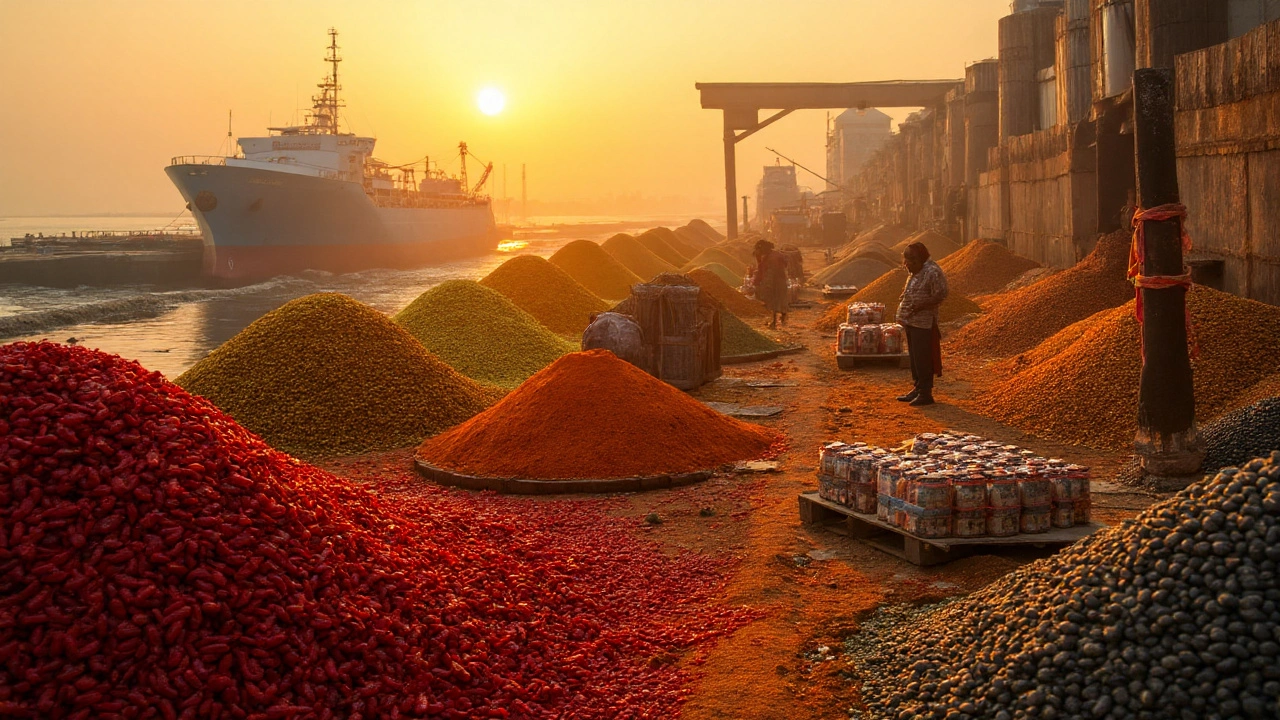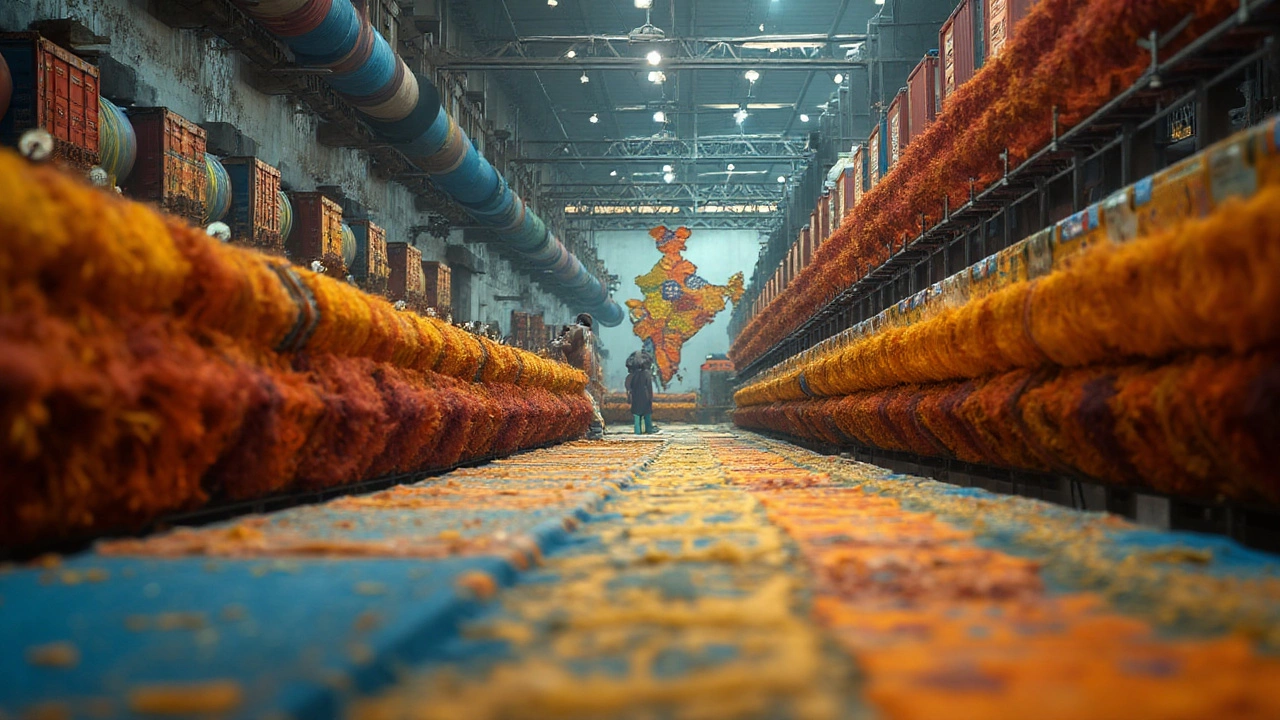India Manufacturing Export Earnings Calculator
This tool estimates potential export earnings from India's top five manufacturing sectors based on their production values and assumed export percentages.
India's manufacturing sector is a broad economic engine that spans automobiles, pharmaceuticals, textiles, steel, electronics and many emerging fields. It contributes roughly 16% of the nation’s GDP, employs over 120million people, and supplies goods to more than 200 countries. Understanding what India manufacturing focuses on helps investors, policymakers, and job‑seekers see where the biggest opportunities lie.
Why the manufacturing mix matters
India’s industrial mix isn’t just numbers on a chart; it reflects regional strengths, historic skill bases, and government policy. The "Make in India" campaign, launched in 2014, pushed for higher domestic value‑addition, better tech adoption, and export diversification. That push reshaped which sectors grew fastest and where new clusters appeared.
Automobile Industry
Automobile industry is a high‑value manufacturing segment that produces passenger cars, two‑wheelers, commercial vehicles, and auto components. In FY2023‑24, it generated about $115billion in revenue, making it the second‑largest manufacturing sector after textiles. Major hubs like Chennai, Pune, and Gurgaon host plants from Tata, Mahindra, Maruti Suzuki, and global OEMs such as Hyundai and Honda.
The sector’s strength lies in a well‑developed supplier network, a large domestic market of over 300million vehicle owners, and a growing export footprint to Africa, the Middle East, and Latin America.
Pharmaceutical Industry
Pharmaceutical industry is a knowledge‑intensive manufacturing domain that produces generic medicines, active pharmaceutical ingredients (APIs), and vaccines. India supplies roughly 20% of the world’s generic drugs and 40% of the vaccines used in developing nations. Revenue topped $42billion in 2023, with R&D centers concentrated in Hyderabad, Mumbai, and Ahmedabad.
Strong regulatory approvals (US FDA, WHO) and a low‑cost skilled workforce keep the sector competitive, while recent COVID‑19 vaccine production highlighted its strategic importance.
Textile Industry
Textile industry is a traditional manufacturing pillar that includes cotton yarn, garments, handloom products, and technical textiles. It remains the largest manufacturing employer, with about 45million workers, and produced $65billion in output in 2022‑23. Key regions are Tamil Nadu, Gujarat, and West Bengal.
India is the world’s second‑largest cotton producer and a leading exporter of readymade garments, thanks to competitive labor costs and a growing domestic fashion market.
Steel Industry
Steel industry is a heavy‑weight manufacturing sector that extracts iron ore, processes steel, and supplies billets, rods, and sheets for construction, automotive, and infrastructure projects. It contributed $87billion in 2023, with Tata Steel, JSW Steel, and Steel Authority of India Limited (SAIL) leading production. Major plants sit in Jharkhand, Odisha, and Karnataka.
Domestic demand is fueled by rapid urbanization, the government's push for affordable housing, and renewable‑energy projects requiring steel for turbines and transmission lines.

Electronics Industry
Electronics industry is a high‑tech manufacturing segment that assembles smartphones, consumer electronics, semiconductor components, and telecom gear. The sector crossed $100billion in exports in FY2023‑24, driven by companies like Samsung, Apple, and Foxconn setting up assembly lines in Pune, Chennai, and Bengaluru.
Government incentives such as the Production‑Linked Incentive (PLI) scheme aim to boost domestic component manufacturing, reducing reliance on imports and creating a more resilient supply chain.
Emerging and Niche Sectors
Beyond the traditional heavyweights, India is fast‑tracking newer fields. The defense manufacturing ecosystem now produces missile systems, armored vehicles, and naval vessels under the "Make in India - Defence" umbrella. Renewable‑energy equipment, especially solar panel frames and wind‑turbine components, is gaining traction in Gujarat and TamilNadu. Furniture, plastic, and chemical manufacturing also see steady growth, often linked to exports to the Middle East and Africa.
Economic Impact Snapshot
All manufacturing sub‑sectors together account for roughly 16% of India’s GDP and employ over 120million workers, making it the second‑largest source of employment after agriculture. Export earnings from manufactured goods crossed $240billion in 2023, representing about 30% of the country’s total export basket.
| Sector | Revenue (USDbn) | % of Total Manufacturing Output | Direct Employment (million) |
|---|---|---|---|
| Textiles | 65 | 22% | 45 |
| Automobiles | 115 | 19% | 12 |
| Electronics | 100 | 17% | 8 |
| Steel | 87 | 15% | 6 |
| Pharmaceuticals | 42 | 12% | 4 |
Challenges Facing Indian Manufacturing
- Infrastructure gaps: Power reliability, logistics bottlenecks, and port congestion raise costs.
- Skill shortages: While labor is abundant, high‑skill talent for advanced robotics and R&D remains scarce.
- Regulatory complexity: Varying state policies and lengthy approval processes can deter foreign investors.
- Environmental compliance: Growing pressure to adopt greener processes, especially in steel and chemicals.
Addressing these issues requires coordinated policy reforms, continued investment in skill‑development programs, and adoption of Industry4.0 technologies.
How the Landscape Fits Into the Bigger Knowledge Cluster
This article sits within the broader "Manufacturing in India" cluster, which also covers topics like "State‑wise manufacturing hubs", "Impact of the Make in India policy", and "Future of Indian Industry 2030". Readers interested in the policy side can explore the next piece on "Make in India: Incentives and Outcomes". Those wanting a deeper dive into regional strengths might look at "Automotive Clusters in Pune vs. Chennai".
Next Steps for Readers
- Identify which sector aligns with your career or investment goals.
- Research regional clusters for that sector - e.g., textiles in TamilNadu or electronics in Bengaluru.
- Check government incentive portals for PLI schemes, export subsidies, or skill‑training grants.
- Connect with industry associations such as CII, FICCI, or sector‑specific bodies for networking.

Frequently Asked Questions
Which industry is the largest employer in India’s manufacturing?
The textile industry tops the list, employing about 45million workers, roughly 37% of total manufacturing employment.
What percentage of India’s export earnings comes from manufactured goods?
Manufactured goods generate roughly 30% of India’s overall export revenue, with electronics and textiles leading the pack.
How has the "Make in India" initiative affected the automotive sector?
The initiative attracted foreign OEMs to set up plants, boosted local component manufacturing, and helped the sector reach $115billion in revenue by 2024.
Are there any government incentives for pharmaceutical R&D?
Yes, the Ministry of Chemicals and Fertilizers offers tax rebates, and several states provide subsidised land and grant‑based funding for drug‑development labs.
Which Indian state leads in steel production?
Jharkhand, aided by rich iron‑ore reserves and large integrated plants, is the top steel‑producing state, followed by Odisha and Karnataka.
What are the biggest challenges for the electronics manufacturing sector?
Key hurdles include dependence on imported semiconductors, the need for higher‑skill labour, and the pressure to meet global quality certifications.
How does India's textile export performance compare globally?
India ranks second worldwide in garment exports, trailing only Bangladesh, and is the largest exporter of cotton yarn and home textiles.
